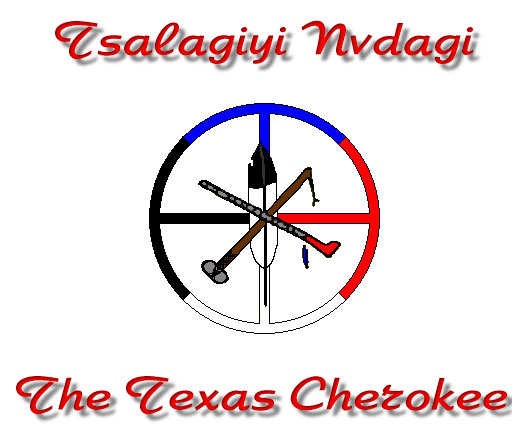Permanent Homeland and Sacred Preservation Effort
We have a long-term vision for two critical and deeply meaningful initiatives for the Tsalagiyi Nvdagi Tribe.
1. Establishing a Permanent Homeland and Administrative Center
2. Preserving the Battle of the Neches Second Battlefield Site
We believe, united as a tribe, we are capable of recovering our culture, spirituality and traditions for the good of our people, today, and for future generations yet to come.
Who we are.
We who have come together to advance our tribe are a very proud people. We will last as long as there is a drop of Ani-Tsalagi blood left among us.
The Tsalagiyi Nvdagi Tribe, under the name of Texas Cherokee, signed a treaty with the Republic of Texas on February 23, 1836. Texas violated that treaty when they attempted to expel the Texas Cherokee and their related bands from Texas by gun and knife on July 16, 1839, and Chief Diwali (Bowles) was killed. Those who survived the massacre fled their Spanish Land Grant and scattered to South Texas, Northern Mexico, West Texas or hid in the deep forest of East Texas to avoid suffering a similar fate. Some Texas Cherokee families were able to return to their fields and land or purchase new property assimilating as a means of survival into the Hispanic or Anglo communities of East Texas as “Black Dutch”, “Spanish”, “Sabine” or “Hispano American.”
We are not a United States Federally Recognized Tribe and do not plan to seek federal recognition as our ancestors never signed a treaty with the U.S. Federal Government. The Tsalagiyi Nvdagi Tribe has retained our Individual and Tribal sovereignty having never surrendered to any foreign army or government. We are officially recognized by the Free and Sovereign State of Coahuila de Zaragoza and Federally Recognized by the United Mexican States under the San Andres Accords August 31, 2001.
The Tsalagiyi Nvdagi Tribe was granted Official Tribal Recognition by Honorable Governor Greg Abbott on behalf of the State of Texas on October 10, 2019. We are not governed by or under any jurisdiction, or part of the Cherokee Nation of Oklahoma (CNO), United Keetoowah Band (UKB), or Eastern Band of Cherokee Indians (EBCI). Despite sharing common roots the Tsalagiyi Nvdagi are a distinct and unique Ani-Tsalagi people. Our ancestors were settled in Spanish Texas with a working tribal government by 1819 where we remain to this day!
The Tsalagiyi Nvdagi Tribal Council is tasked with promoting the general welfare and justice for the Tsalagiyi Nvdagi People; acquiring resources for the benefit of its people; protecting the tribes Indigenous Native American heritage including but not limited to their traditions, spirituality, ceremonies, language, unique Ani-Tsalagi culture, and sacred history; preserving, securing, and expressing all the inherent sovereign rights and powers of an Indigenous Native American Tribe; and continuing relations with the United States of America, State of Texas, United Mexican States, and the free and sovereign State of Coahuila de Zaragoza.
Our headquarters
Located in southern Smith County just two miles from the northern border of Cherokee County is in the area that was once the land of the treaty with the Republic of Texas. It covered all of Cherokee County, Smith County and a number of square miles of land outside that area.
For information about Tribal Citizenship, please visit the link below.
If you would like to contact the Tribe, or one of our Chiefs, please visit our Contact Page at the link below.
Our Latest News…
This flute music is called “Rolling Thunder”.
Created by: Wado Pale Wolf.
She has graciously allowed it to be played here.
This flute music is called “Rolling Thunder”.










